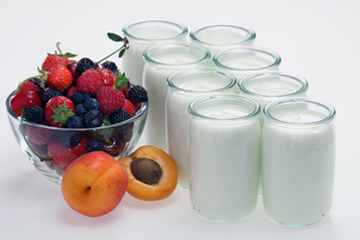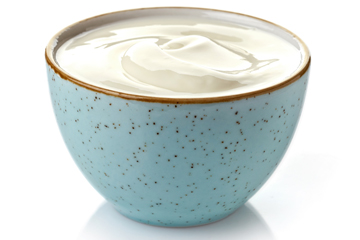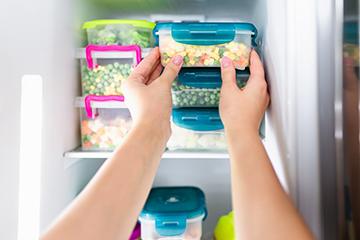
Making Yogurt at Home

Yogurt: By definition, it is a cultured milk product containing live bacteria. Federal standard of identity regulations require that a product specifically include Lactobacillus bulgaricus and Streptococcus thermophilus bacteria in order to be called “yogurt.”
Homemade yogurt has become increasingly popular in recent years. If you’re among those who will make your own yogurt with a stand-alone yogurt maker or electric pressure cooker, make sure you follow these basic food science and food safety principles:
- Clean and sanitize. Use hot, soapy water to clean all workspaces and equipment, and follow that up with a hot-water rinse and a sanitizing solution. Consider using the dishwasher for utensils and storage containers. Protect starter cultures from contamination by keeping them sealed until you are ready to use them.
- Temperature control. An accurate food thermometer is essential for monitoring the various yogurt-making stages. During preparation, heating milk to 180 degrees F kills any competing bacteria and denatures whey proteins. Before inoculation, or adding the starter cultures, the milk must be cooled to 115 degrees F. During the incubation period of four to eight hours, maintaining a temperature of 100–110 degrees F is essential for proper fermentation. The final step, refrigeration, will stop the development of lactic acid and halt the fermentation process.
- Correct ingredients. The only ingredients you need to make yogurt are milk and starter cultures. Dry starter cultures are available in health food stores or via online sources, but a commercial plain yogurt with live and active cultures is an easier alternative. You can use either high- or low-fat milk. Pasteurized milk, either as purchased or as a first step in preparation, is essential to the fermentation process as well as to food safety. Yogurt forms when bacteria in the starter ferment the milk sugar into lactic acid. The lactic acid makes the milk more acidic, causing its proteins to coagulate. The more lactic acid that’s produced, the tangier the yogurt will taste. The types of milk and starter that you use and the incubation time will all influence the final taste and consistency of the yogurt.
If you are ready to try your hand at yogurt making with a new appliance like an electric pressure cooker, the “Plain Yogurt” recipe included in this newsletter is a simple one with which to start.
Plain Yogurt

Yield: 5 servings (6 ounces each)
Ingredients:
- 3½ cups milk (whole, skim or your preference)
- 1 tablespoon plain yogurt with live active cultures (to serve as your starter)
- 2 tablespoons maple syrup, honey, agave or sweetened condensed milk (optional)
Directions for electric pressure pots without a yogurt setting:
- Heat the milk on low in a saucepan until the temperature reaches 180 degrees F. Turn off the heat, and, monitoring with a kitchen thermometer, let the milk cool to 115 degrees F. Remove any film that forms on top of the milk to avoid giving your yogurt a bad texture.
- If desired, add sweetener and stir well. Place the yogurt (starter) into a bowl, add 1 cup of the warm milk and whisk so it’s completely smooth. Add the mixture back into the rest of the milk and stir well.
- Ladle the mixture into sanitized 8-ounce jars, and cover with lids and rings. Place the trivet into the electric pressure cooker pan and press the keep warm button. Place the jars on top of the trivet without covering the pressure pot. Clip a candy thermometer to the edge of the inner pot to monitor and keep the temperature at 100–110 degrees F. Set the timer for eight hours. If necessary, place a paper towel over the top of the pot to help maintain the temperature.
If you don’t have an electric pressure cooker, find another way (such as in an oven) to maintain the yogurt temperature at 100–110 degrees F for eight hours. - After eight hours, place the jars into the refrigerator for at least six hours before serving. Enjoy!
Nutrition information: 120 calories, 6 grams (g) fat, 12 g carbohydrate, 6 g protein, 213 milligrams calcium
Sources:
Tsevdos, Natalie. 2018. Yogurt. Food Source Information. Colorado State University.
Cornell University. Milk facts. . (No longer available online.)
Smith, Diane K. 2015. Yogurt made simple. Washington State University Extension.
Food is a Four Letter Word. Yogurt.
New Year’s Resolution: Keep Your Freezer Organized!

The new year is a great time to resolve to keep your freezer organized and ready to hold the upcoming year’s harvest.
Organize your freezer’s contents into food groups to make it easier to locate different products when you need them. For example, keep all the vegetables together and all the fruits together. Arrange the packages so that the ones that have been in the freezer the longest are most easily accessible, so you will use those first. Keep a refrigerator/freezer thermometer in your freezer and check it regularly to be sure that the temperature stays at zero degrees F or lower in order to maintain the best quality.
Sources:
National Center for Home Food Preservation. General freezing information.